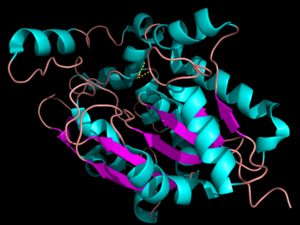Sandbox Reserved 914
From Proteopedia
(Difference between revisions)
| Line 30: | Line 30: | ||
==Medical Relevance== | ==Medical Relevance== | ||
| - | PPT1 mutations and a decrease or depletion of PPT1 are the root cause of several diseases. Infantile neuronal ceroid lipofuscinosis (INCF) is characterized by impaired mental and motor development, including difficulty with walking, speaking, and intellectual function, beginning around the first or second year of life<ref name="PPT">PPT1. Genetics Home Reference. | + | PPT1 mutations and a decrease or depletion of PPT1 are the root cause of several diseases. Infantile neuronal ceroid lipofuscinosis (INCF) is characterized by impaired mental and motor development, including difficulty with walking, speaking, and intellectual function, beginning around the first or second year of life<ref name="PPT">"PPT1." Genetics Home Reference. N.p., Aug. 2013. Web. 10 Apr. 2014.</ref>. The PPT1 mutation involved in INCF replaces an arginine with a stop signal in the instructions to make the enzyme. This mutation leads to a vast reduction in the production of PPT1, which impairs the removal of fatty acids from proteins. This impaired removal leads to fatty acid accumulations throughout the body, particularly in neuronal cells in the brain<ref name="PPT"/>. Late-infantile neuronal ceroid lipofuscinosis has the same characteristics as INCF, but the mutation varies slightly. This leads to a slight reduction in the activity of PPT1 instead of completely wiping it out<ref name="PPT"/>. |
Mutations can also cause premature stop signals to be added to the instructions to create PPT1, resulting in Kufs disease<ref name="PPT"/>. This is characterized by seizures, problems with movement, and a decline of intellectual function, usually beginning in early adulthood<ref name="PPT"/>. Although premature stop signals are added, these mutations allow enough PPT1 to be produced so that the onset is later on in life and the life expectancy is higher. | Mutations can also cause premature stop signals to be added to the instructions to create PPT1, resulting in Kufs disease<ref name="PPT"/>. This is characterized by seizures, problems with movement, and a decline of intellectual function, usually beginning in early adulthood<ref name="PPT"/>. Although premature stop signals are added, these mutations allow enough PPT1 to be produced so that the onset is later on in life and the life expectancy is higher. | ||
Revision as of 12:39, 22 April 2014
ββ
| This Sandbox is Reserved from Jan 06, 2014, through Aug 22, 2014 for use by the Biochemistry II class at the Butler University at Indianapolis, IN USA taught by R. Jeremy Johnson. This reservation includes Sandbox Reserved 911 through Sandbox Reserved 922. |
To get started:
More help: Help:Editing |
Palmitoyl-Protein Thioesterase 1
| |||||||||||
References
- ↑ 1.0 1.1 1.2 1.3 1.4 1.5 1.6 "Palmitoyl Protein Thioesterase 1." UniProt. N.p., 1 Oct. 1996. Web. 10 Apr. 2014.
- ↑ 2.0 2.1 2.2 2.3 2.4 2.5 2.6 2.7 2.8 "PPT1." Genetics Home Reference. N.p., Aug. 2013. Web. 10 Apr. 2014.
- ↑ 3.0 3.1 3.2 3.3 3.4 3.5 3.6 3.7 Bellizzi JJ 3rd, Widom J, Kemp C, Lu JY, Das AK, Hofmann SL, Clardy J. The crystal structure of palmitoyl protein thioesterase 1 and the molecular basis of infantile neuronal ceroid lipofuscinosis. Proc Natl Acad Sci U S A. 2000 Apr 25;97(9):4573-8. PMID:10781062 doi:10.1073/pnas.080508097
- ↑ 4.0 4.1 4.2 Branneby, Cecilia. Exploiting Enzyme Promiscuity for Rational Design. KTH Biotechnology. N.p., May 2005
External Resources
http://en.wikipedia.org/wiki/Palmitoyl_protein_thioesterase
https://www.counsyl.com/diseases/ppt1-related-neuronal-ceroid-lipofuscinosis/
http://en.wikipedia.org/wiki/Alpha/beta_hydrolase_fold
http://en.wikipedia.org/wiki/Catalytic_triad
http://www.biomedcentral.com/1471-2121/8/22
http://www.genecards.org/cgi-bin/carddisp.pl?gene=PPT1

